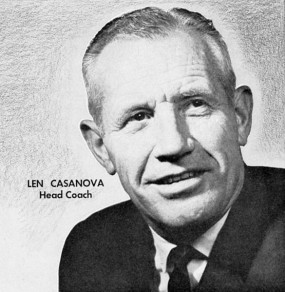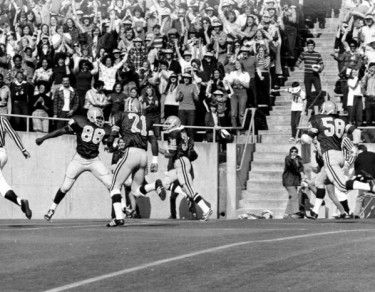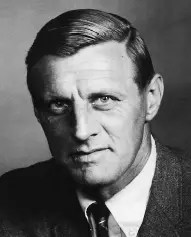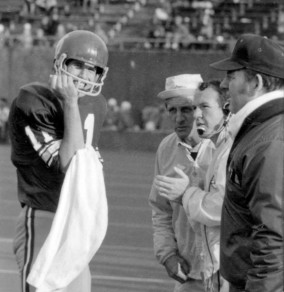The University of Oregon has had some great football coaches throughout the ages that have all helped, in one way or another, make the Ducks what they are today. From the start of the Oregon football program to now, Oregon has had coaches that have helped shape football not only at Oregon, but all over the country.
1951-1966
In the middle of the 20th century, Oregon hired away a coach from a major college football program Back East when the Ducks brought Len Casanova to Eugene from the University of Pittsburgh.
The first two years of Casanova’s tenure at Oregon had them winning only two games, while the coach rebuilt the team, leading them to a winning season in 1954. In 1953, the Ducks played one of the earliest nationally-televised games, against Nebraska — winning 20-12.
In 1957, the Ducks were crowned the Pacific Coast Conference champions, earning a berth in the 1958 Rose Bowl, their first since 1917. Oregon’s opponent was the No. 2 nationally-ranked Ohio State Buckeyes, who were 21-point favorites. Football fans gave Oregon little hope, as up to the 1957 season, the Big Ten was 10-1 against the Pacific Coast Conference in the Rose Bowl series.
The Ducks shocked everyone by digging in and giving the Buckeyes a fight, matching them touchdown for touchdown, until a 34-yard field goal by Ohio State late in the fourth quarter, followed by a Duck fumble, sealed their fate. After the game, Bill Leiser of the San Francisco Chronicle reported:
“A kick that sailed true, 34 yards through the upright posts, as against one that did not, won for Ohio State the finest football game of modern Tournament of Roses history this balmy afternoon, 10-7. Tabbed for a three touchdown licking, Casanova’s Oregon Ducks refused to accept the odds and matched the more numerous and more powerful athletes from the Big Ten blow for blow, yard for yard, and touchdown for touchdown. The kicks, I swear, were from exactly the same one single spot or hash mark, at the same exact angle from the same side of the field.”
After the Rose Bowl, Casanova was honored as the season’s most highly-recognized football coach in the country.
In the 16 years that Len Casanova coached at Oregon, he took them to the Liberty Bowl in 1960 and the Sun Bowl in 1963. He always credited much of his success to his assistant coaches, some of whom went on to have great head coaching careers.
As history would have it, the Len Casanova coaching tree bore many fruit:
John McKay, his first offensive coordinator, was later the head coach at USC. Other assistants included John Robinson, who became a head coach at USC and the NFL Rams; Bruce Snyder, later head coach at Cal and Arizona State; and Jerry Frei, later head coach at Oregon.
Casanova retired as Oregon’s head football coach in 1966 and was then appointed Athletic Director, where he served for four years before retiring in 1970. It was during his tenure at Oregon that the 46,000-seat Autzen Stadium was built and on September 27, 1991, the University of Oregon dedicated the new Len Casanova Athletic Center. His record at Oregon was 82-73-8.
1967-1976
Frei, an assistant coach under Casanova became the head coach in 1967, the first year Oregon played in Autzen Stadium. In his four seasons at Oregon, Frei’s teams were never selected for a bowl game. In 1970, he coached the Ducks in an improbable comeback at UCLA, scoring 20 points in the last four minutes of the game, winning 41-40.
He couldn’t defeat arch-rival Oregon State, however, and by the end of the 1971 season, some boosters were reportedly demanding significant changes in his coaching staff. Frei resigned in January of 1972, citing disagreements with those boosters. He left Oregon with a 22-29-2 record.
After interviewing several established head coaches from programs around the country, Oregon hired Frei’s offensive line coach, Dick Enright. Enright had the least amount of experience from all coaches interviewed by far, having only coached in college football for two seasons. Through his tenure, Enright had trouble maintaining team discipline and consistent play, and famously tried to make Dan Fouts — who wasn’t a runner — into a option quarterback.
Although he beats Oregon State in 1972 for the first time in nine years, he produces only six wins in two seasons at Oregon, and was fired at the end of 1973 after complaining to the media about what he considered were sub-standard football facilities.
Enright was replaced by his quarterback coach, Don Read, who had trouble fielding a competitive team in his first job as a major college head coach. It was during his three seasons that Oregon had it’s longest losing streak — 14 games — and also had the team’s worst loss in history (66-0 at Washington in 1974). Read was fired with a year still left on his contract after the end of the 1976 season. He went 3-18 in conference play (9-24 total), being shut out seven times and only one win over a team with a winning record.
Announcing Read’s firing, Athletic Director John Caine revealed the football program had lost money the last three seasons, which was drawing funds away from a successful basketball program and cutting into the budgets for wresting, baseball and track, instead of providing funding for those non-revenue sports.
He also announced that the suffering program would need to go in another direction for the next hire saying, “The successor will not come from the current staff. … There is a need for a different approach than [what] we’ve had here for a number of years. … I’m looking for a multi-talented individual, one with perhaps a different personality and a different background.”
The course set by the Athletic Department in that one statement led the Oregon football program to what it has become today. The rest of the 20th century, and what we’ve seen so far of the 21st, has brought along great coaches. These may have been the difficult years, but they were a turning point for greatness to come as Oregon, once again, would become a nexus of coaching excellence.
Enter Rich Brooks.
Top Photo from Univ. of Oregon Library Archives
Pat Pannu (Editor and Writer) is a recent graduate of the University of Oregon. Pat’s been a crazy Duck fan since she moved to Oregon in early 2004 and has been 95% of all home games since the 2005 football season. She loves to talk about sports though those talks somehow always end in arguments. Pat loves to hear other’s view of the sports and teams that she loves and can’t wait to hear from you all. Follow her on twitter @patpannu






